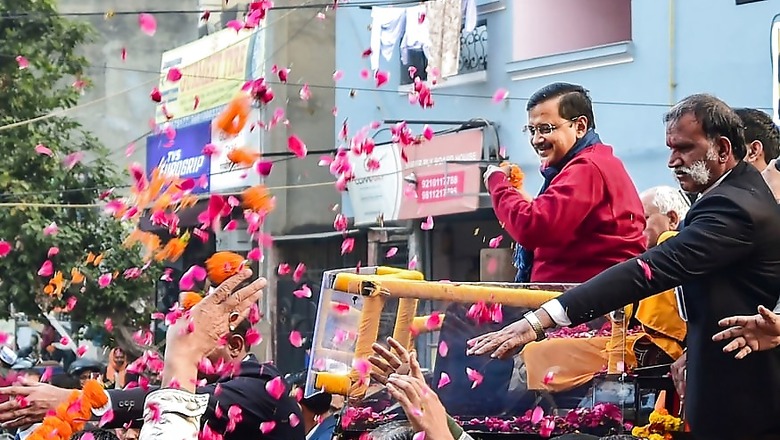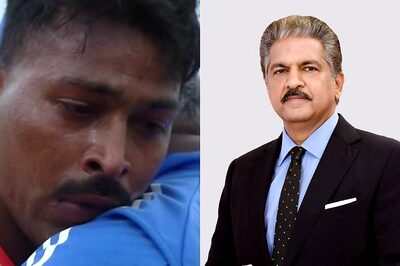From 'Son of Anarchy' to 'Son of Delhi': How AAP Overhauled Brand Kejriwal to Win Delhi for 3rd Time

views
While it was clear at the beginning of the campaigning for Delhi elections 2020 that for the Aam Aadmi Party led by chief minister Arvind Kejriwal this was a do-or-die battle, it was evident in the last two weeks that the stakes were even higher for the Bharatiya Janata Party.
The BJP’s posters across Delhi with the face of Prime Minister Narendra Modi highlighted the Citizenship Amendment Act, abrogation of Article 370 provisions for Jammu and Kashmir, criminalisation of triple talaq, and the Balakot air strikes. Home minister Amit Shah led from the front in a no-holds-barred campaign where the anti-CAA protests at Shaheen Bagh figured on top of the agenda.
In the BJP’s Jeet ki Goonj programme on January 25, Shah said, “Kamal ke button ko itni zor se dabana ki us button ke current se hi February 8 ki sham ko hi Shaheen Bagh waale uth kar chale jayein (Press the Lotus button on the EVM with such force that the current it generates makes the Shaheen Bagh protesters go back to their homes on the evening of February 8).”
The not-so-subtle strategy was to polarise voters. According to the 2011 census, 81.86% of Delhi’s population comprised Hindus and 12.86% were Muslims. And, unlike last year’s elections in Haryana, Maharashtra and Jharkhand, the anti-CAA protests sprung up the capital just weeks before the February 8 polls, kicking off on December 15.
For the BJP, a loss in Delhi, with 81.86% Hindus, would be seen by critics as a referendum against the CAA as well as a rejection of its high-pitched and polarising campaign. With no state elections round the corner – the next big ones are in Bihar towards the end of the year and West Bengal in mid-2021 – this could send out a message across the country. The AAP chief’s response to the strong challenge by the BJP captures the essence of the reimagined Arvind Kejriwal.
The AAP chief reasserted his Hindu identity and assiduously avoided being identified with the Muslim community. Perhaps the biggest shift in Kejriwal’s position was in his handling of the massive protests against the CAA and the National Register of Citizens (NRC) that erupted in Delhi mid-December.
While AAP had voted against the CAA Bill in Parliament, Kejriwal, who had in November 2016 rushed to the Mayapuri police station to secure the release of missing Jawaharlal Nehru University (JNU) student Najeeb Ahmed’s mother Fatima, was determined not to be pulled in this time. So, whether it was the police crackdown at Jamia Millia Islamia on December 15, the violence at JNU on January 5 when masked men and women went on a rampage, the detention of protesters, or students landing in hospitals with injuries, the AAP chief restricted himself to simply tweeting, providing ambulances, letting the Congress party take a more strident position.
AAP even strategically stayed away from a Congress-led opposition parties’ meet against the CAA. Even as wave upon wave of protest engulfed the capital intermittently, Kejriwal, who was once seen as a fierce and consistent voice against Narendra Modi, was extremely measured in his utterances against the revised citizenship law, cleverly framing his opposition, not as pro-Muslim, but as pro-India. “What was the need for this? The whole economy is in a mess,” he said. “Where will you settle the lakhs of migrants who come from Pakistan?”
Kejriwal went a step ahead and, less than a week before Delhi voted, revealed that he was a Hanuman devotee and even recited the Hanuman Chalisa to drive home the message that he was an ‘authentic Hindu’. While it may be seen as a political stunt, it did appear to take the wind out of the BJP’s attempts to portray itself as the champion of ‘Hinduism’ or the ‘interests of Hindus’.
In his last press conference on February 6 as incumbent chief minister, Kejriwal challenged home minister Amit Shah to a public debate, declaring that he was ready to engage even on Shaheen Bagh. Going further, the AAP chief claimed that BJP leaders were fake Hindus. “Gita mein likha hai, maidan chhodke nahi bhaagna chaahiye. Ek sachcha Hindu jo hota hai, woh bahadur hota hai, woh maidan chhodke is tarah bhaagta nahi (It’s mentioned in the Gita that never run away from the battlefield. A true Hindu is brave, he doesn’t abandon the battlefield like this).”
The message again and again was that the BJP is not the sole custodian of Hindu identity. While it seems to have worked on the ground, it also, surprisingly, appeared to have found resonance in the Rashtriya Swayamsevak Sangh. On Sunday, RSS general secretary Suresh ‘Bhaiyyaji’ Joshi said, “Hindu community does not mean the Bharatiya Janata Party, and opposing the BJP does not amount to opposing Hindus. Political fight should continue, but it should not be linked to Hindus.”
The reclaiming of this political space for AAP may have come at some cost. While the party supported rabble-rousing Muslim leaders as candidates – even taking in Shoaib Iqbal who contested and won as MLA multiple times on tickets from different parties, and going all out to support its Okhla legislator Amanatullah Khan when his name was dragged into controversies twice during canvassing – Kejriwal stayed away from campaigning visibly in any of the seats reserved for minorities.
In another huge break from the past two assembly elections that Kejriwal fought, the battle for 2020 saw the AAP chief spare considerable time for town halls, 13 of them, that were broadcast live across television channels. These helped establish Brand Kejriwal, giving the chief minister an open platform to amplify the welfare schemes of the government as well as clarify his stand on maintaining a distance from Shaheen Bagh and Jamia.
In one such event, Kejriwal argued passionately that he had not distanced himself from Shaheen Bagh as his government had worked on schools and hospitals over there like everywhere else. In fact, he sought to turn the tables on home minister Shah, saying if the AAP government had control over the police, then “we would have cleared the area (Shaheen Bagh protest site) within two hours”. “Amit Shah is the home minister, he is so powerful. You think he cannot clear a road if he wants to? He does not want to as he wants to fight the entire Delhi election on Shaheen Bagh. The BJP has no other issue.” Kejriwal also said that while everyone had a right to protest, no one had the right to inconvenience others. Significantly, earlier in the day, his deputy, Manish Sisodia, had declared in another TV show that AAP stood with the Shaheen Bagh protesters.
In 2020, nearly a decade after he burst onto the Indian political scene, it was a vastly different Kejriwal on the campaign trail – the angry young man of Indian politics gave way to a much mellowed and practical Kejriwal. In Parliament, for instance, AAP voted in favour of revocation of Article 370 provisions that gave Jammu and Kashmir its special status, leading to splitting of the state into two Union Territories. In 2020, the disrupter, outsider, and challenger – all in one – sought a mandate on the AAP government’s five-year performance.
If in 2015, the slogans were “Puri bahumat deke toh dekho, aam aadmi ki takat dekho (Give full majority and see the power of the common man)”, “Dilli kahe dil se, Kejriwal phir se (Delhi says from its heart, Kejriwal once more), and “Paanch saal Kejriwal (Five years for Kejriwal)”, in 2020 the slogan was “Acche beete paanch saal, lage raho Kejriwal (The past five years have been good, keep at it Kejriwal)” and, with 10 days to go for voting, this was tweaked to a more definite and futuristic “Acche honge paanch saal, lage raho Kejriwal (The next five years will be good, keep at it Kejriwal)”. Notice the subtle manner in which AAP has played on the promise of “Acche Din (Good days)” by Narendra Modi on the campaign trail ahead of the 2014 parliamentary polls.
But that is not the only similarity in AAP’s 2020 campaign with the BJP’s 2014 and 2019 campaigns. The BJP successfully sold the idea of “Modi vs Who?” while highlighting the leadership vacuum in the opposition ranks.
In 2020, AAP has done exactly the same with “Kejriwal vs Who?” The party even put up posters on January 1, 2020, wishing luck to the BJP’s ‘seven chief ministerial candidates’, and on February 4, less than 72 hours before curtains would be drawn on the campaign, Kejriwal challenged the BJP to name its CM face.
“Amit Shah is saying, ‘Give us votes, and then we will decide’. In a democracy, the citizens decide who the CM will be, not Amit Shah,” he had said.
Though not factually accurate, this was vintage Kejriwal, sending out a cleverly crafted political message, doing what the BJP has done before.
Also, the manner in which Kejriwal responded to jibes from BJP leaders of being an “anti-national”, and “terrorist” is reminiscent of the manner in which Narendra Modi had reacted to attacks by opponents. Pitching himself as the elder son who takes care of the family’s expenses, as a brother who acts for the welfare of the family, and the son of Delhi, Kejriwal argued that those who believe that he is a terrorist may press the button with the symbol of Lotus (of the BJP), but those who believe that he had worked for Delhi and the country should vote for the Broom symbol (of AAP) on February 8.
Similarly, taking potshots at the BJP’s use of 200 MPs, and seven chief ministers in its campaign, the AAP chief said, “So many parties from across India have come here. Earlier there were only three major parties – the BJP, Congress and AAP. This time, all parties have joined hands – BJP, Congress, LJP, RJD, JD(U). And their only aim is to defeat Kejriwal. When I say I am building good schools, they say ‘defeat Kejriwal’. When I say that I am making good hospitals, they say ‘defeat Kejriwal’. Their only aim is to defeat Kejriwal, but Kejriwal can be defeated only by the people.”
Team Kejriwal has been closely looking at the template of five-time Odisha chief minister Naveen Patnaik, who made it a point to say that 4 crore Odias are his family. Kejriwal said in the run-up to the Delhi polls that 2 crore Delhiites are his family. And while the AAP chief took on Amit Shah, in a departure from the past, he refrained from taking on Prime Minister Modi.
What stands out in AAP’s campaign for Delhi 2020 is its unswerving focus on work. Right from the start, the AAP slogan was “Yeh chunav kaam par hoga (This election will be fought on the issue of performance)”. When Shah challenged the party’s claims about CCTV cameras and schools, Kejriwal cleverly said he was happy that the BJP in Delhi was forced to talk about schools and hospitals while in other states it talks of divisive issues.
Confident of AAP’s welfare schemes reaching every door and making a difference, especially to lakhs of people from the disadvantaged sections, Kejriwal was perhaps the first political leader to announce, “If you think I have done work, then vote for me. If you think I have not, don’t vote for me.”
While detractors have hit out at the party for its “freebie culture”, AAP’s multiple welfare schemes, free electricity for up to 200 units, free water up to 20,000 litres, reforms in government schools, free bus rides for women, pilgrimage programme, and more were also printed on posters and placards and were visible in the party’s rallies.
During the fag end of the campaign, the party coined a new slogan – “Mera vote kaam ko, seedhe Kejriwal ko (My vote goes for work, straight to Kejriwal)” – aiming to pin down the political discourse in Delhi to the agenda of work, capitalising on the highly popular chief minister’s image, and beating any possible anti-incumbency of local MLAs.
Kejriwal wound up his last press conference by saying, “In a way these elections will be historic. AAP’s win will pave the way for a new kind of politics – the politics of performance. The message across the country will be if you want votes, you need to build schools and hospitals.”
And, to those listening, in the dying hours of campaigning for Delhi 2020, Kejriwal also said, “We cannot make the country of 21st century until we have schools, colleges, university, hospitals, research, science and technology. We need to have highways, trains, enter into space to make India a 21st century country. The country will not become developed by dividing Hindus and Muslims.”


















Comments
0 comment